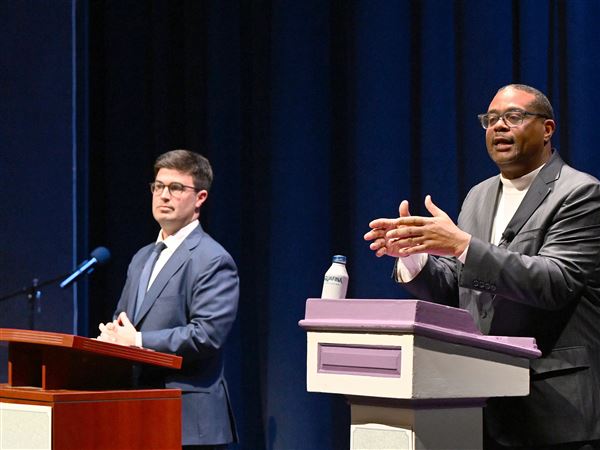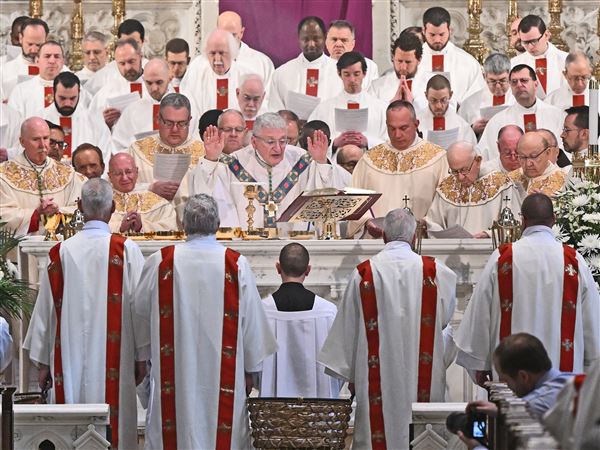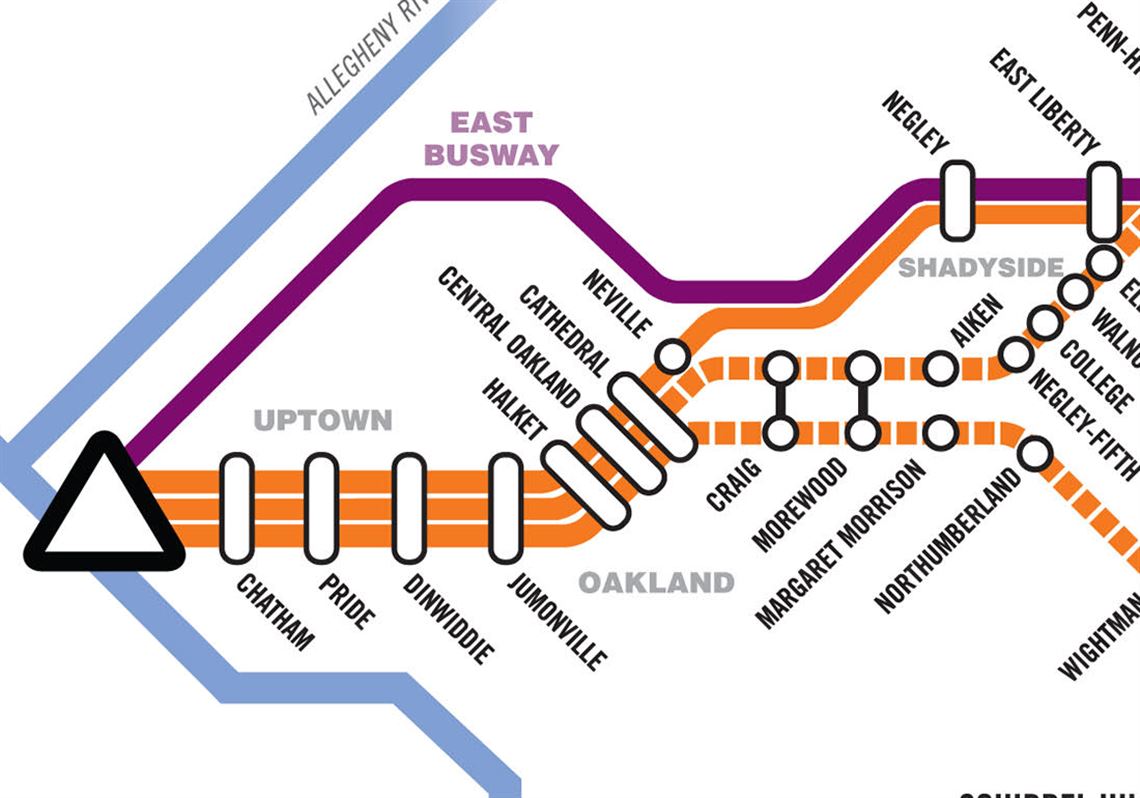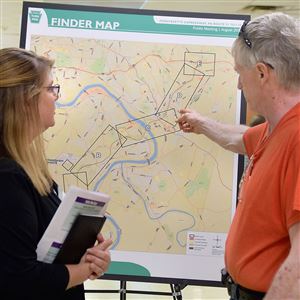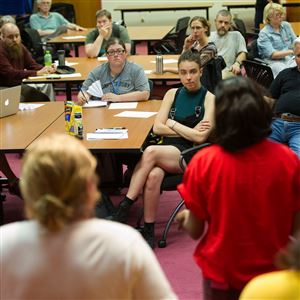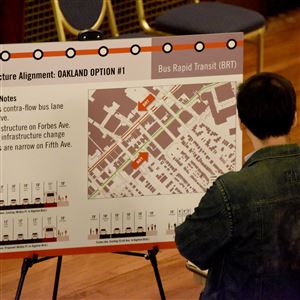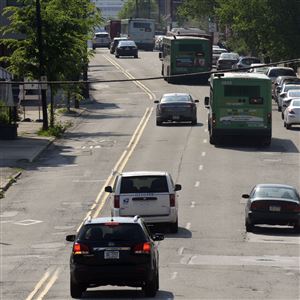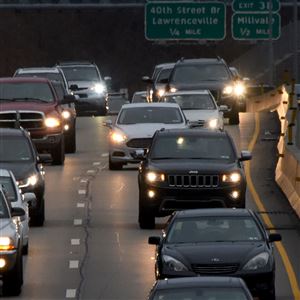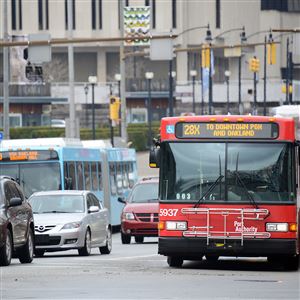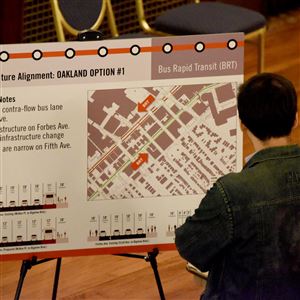Port Authority’s idea for a Bus Rapid Transit system is drawing interest from residents who would benefit from the proposal but also some concerns, including from disabled riders, who are worried that having fewer stations on the system will make it harder to catch a ride.
Port Authority officials have been holding several rounds of public meetings on the Bus Rapid Transit system before a September deadline for federal grant money. And in those meetings across the city, Pittsburghers have been more than willing to express their concerns.
The proposed system will have a core route that runs from Downtown to Wilkinsburg with two branches that split off in Oakland — one to Squirrel Hill and one to Highland Park. Unlike local buses, which have about six stops every mile, BRT buses will have four stops every mile, meaning that they’ll go farther, faster.

The BRT preferred alternative plan. (Port Authority)
The 25 new electric buses also will run in their own bus lanes. That means that some residents will have to go a bit farther to catch a bus.
But Port Authority is still finalizing the location and spacing of stations and paratransit considerations, said Justin Miller, the principal transportation planner with Pittsburgh’s department of mobility and infrastructure.
At public workshops last week in Oakland and Uptown, proposed BRT routes were spread out across tables, and participants were invited to write comments on sticky notes. Many elderly and disabled residents expressed concerns about how changes to streets and bus stops would affect their daily commutes.
Mary Fletcher of Oakland, who attended the Oakland workshop June 19, has been a member of the Committee for Accessible Transportation, an arm of the Port Authority, for at least 15 years. She said committee members sought to reinstate a bus stop on Liberty Avenue between Sixth and Seventh streets so that disabled people would have an easier time getting to the Cultural District. But that stop may be removed under the BRT plan.
“This system will impact the disabled community. We’re actively involved, we’ve got groups, and we’re being ignored,” Ms. Fletcher said.
At the Uptown workshop last Tuesday, several residents raised concerns about a proposed BRT stop at Forbes Avenue and Jumonville Street — a block away from the current stop at Gist Street — which would require deaf and blind riders to navigate an extra block to the Pittsburgh Association for the Deaf.
Under the BRT plan, 75 percent of existing riders would still be within one block of their current bus stop, according to Amy Silbermann, a senior analyst at Port Authority. About 1 percent of riders, particularly those in the area between Oakland and Uptown, would have to walk more than two blocks.
Ms. Silbermann said the BRT bus stops, which range from basic bus shelters to larger stations, will have upgraded amenities, such as seating, protection from the wind and rain and spaces to park wheelchairs.
Sandy Kirkavitch of Uptown said she was concerned about the proposed bike and BRT bus lanes in the 1700 block of Forbes Avenue, where she lives. The street is already narrow, and when she parks next to her house to put her wheelchair in her van, there is already little room to maneuver, she said. With the new lanes, she is worried she might not be able to park outside her house.
“[Some people] have to have parking in front of their homes because of their conditions, and there’s no getting around it. It’s a safety issue as far as residents are concerned,” Ms. Kirkavitch’s friend Lola Dawd of Uptown said.
Through community meetings across the city and data received from a 2,000-person online survey, Port Authority has attempted to incorporate public input in the project.
But many of the system’s details — schedules, fare rates and transfer policies — will be decided only after Port Authority’s application for a Federal Transit Administration “Small Starts” grant is submitted in September. The grant could provide up to $100 million of the $233 million budget, Ms. Silbermann said. Port Authority is seeking the remainder of the money from federal, state and local sources, she added.
Although Port Authority hopes to acquire some new buses, the P3, 61D and 71B will become BRT lines, according to Ms. Silbermann.
Brandin Adams, a student at the University of Pittsburgh Greensburg, said the conversion of the P3 line concerned him because it means that only one bus, the P1, will still go to Swissvale. “The whole point of the extension was to have more access,” he said. “It’s a major concern to people in that area. I have friends and family who access that busway and need to get from point A to point B.”
The public workshops continue this week with a Squirrel Hill-Greenfield meeting scheduled for 6:30 to 8 p.m. Tuesday at the Jewish Community Center of Greater Pittsburgh, 5738 Forbes Ave., and a Downtown meeting scheduled for 6:30 to 8 p.m. Wednesday at the Trust Arts Education Center, 805-807 Liberty Ave.
Eliza Fawcett: efawcett@post-gazette.com or 412-263-1952.
First Published: June 26, 2017, 4:00 a.m.
